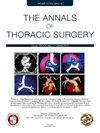微创瓣膜手术治疗感染性心内膜炎的比较研究。
IF 3.6
2区 医学
Q1 CARDIAC & CARDIOVASCULAR SYSTEMS
引用次数: 0
摘要
背景:心内膜炎患者经常需要瓣膜手术,尽管最近微创心脏手术(MICS)在复杂瓣膜手术中的应用有所增加,但共识建议仍然是传统的胸骨切开术。方法:美国胸外科学会(STS)成人心脏外科数据库对2016年1月至2024年3月期间接受心内膜炎瓣膜手术的所有患者进行评估。患者按常规胸骨切开术与MICS入路进行分层,包括半胸骨切开术、右胸切开术和机器人辅助二尖瓣/三尖瓣/主动脉瓣手术。Logistic回归评估了经风险调整后与STS主要发病率或死亡率主要结局的相关性,MICS方法考虑了当前STS风险模型中的所有协变量。结果:741例心内膜炎瓣膜手术患者中位年龄37岁,582例(78.5%)存在物质使用障碍,210例(28.3%)重做胸骨切开术,166例(22.4%)重做瓣膜手术。MICS与二尖瓣修复率较高相关(76.3% vs 48%)。结论:MICS治疗心内膜炎的瓣膜手术安全有效,修复率和风险调整后的结果与开放手术相似。本文章由计算机程序翻译,如有差异,请以英文原文为准。
Minimally Invasive Valve Surgery for Patients With Infective Endocarditis: A Comparative Study
Background
Patients with endocarditis frequently require valve surgical procedure, and despite the recent growth of minimally invasive cardiac surgery (MICS) for complex valve operations, consensus recommendations still suggest conventional sternotomy.
Methods
The institutional Adult Cardiac Surgery Database of The Society of Thoracic Surgeons (STS) evaluated all patients undergoing valve surgical procedure for endocarditis from July 2016 to March 2024. Patients were stratified by conventional sternotomy vs an MICS approach, including hemisternotomy, right thoracotomy, and robotic-assisted mitral, tricuspid, or aortic valve surgical procedure. Logistic regression assessed the risk-adjusted association with the primary outcomes of STS major morbidity or mortality and the MICS approach by accounting for all covariates in current STS risk models.
Results
Of 741 patients undergoing valve surgical procedure for endocarditis, the median age was 37 years, 582 (78.5%) had a substance use disorder, 210 (28.3%) underwent redo sternotomies, and 166 (22.4%) had redo valve operations. MICS was associated with a higher repair rate for mitral valves (76.3% vs 48%; P < .0001) but a lower rate for tricuspid valve (22.5% vs 44.1%; P < .0001), with no difference for aortic valves (8.3% vs 7.4%; P = .372). Before risk adjustment, MICS was associated with longer cross-clamp times (99 minutes vs 86 minutes; P = 0.019) but a lower incidence of STS major morbidity or mortality (15.4% vs 27.8%; P = 0.019). After robust risk adjustment, age (odds ratio [OR], 1.1; P = 0.008), lung disease (OR, 2.2; P = 0.010), preoperative creatinine (OR, 1.3; P = 0.016), and valve repair vs replacement (OR, 0.17; P = 0.002), but not MICS (OR, 1.2; P = 0.807), were independently associated with STS major morbidity and mortality.
Conclusions
MICS valve surgical procedure for endocarditis appears both safe and effective, with repair rates and risk-adjusted outcomes similar to those of open surgical procedure.
求助全文
通过发布文献求助,成功后即可免费获取论文全文。
去求助
来源期刊

Annals of Thoracic Surgery
医学-呼吸系统
CiteScore
6.40
自引率
13.00%
发文量
1235
审稿时长
42 days
期刊介绍:
The mission of The Annals of Thoracic Surgery is to promote scholarship in cardiothoracic surgery patient care, clinical practice, research, education, and policy. As the official journal of two of the largest American associations in its specialty, this leading monthly enjoys outstanding editorial leadership and maintains rigorous selection standards.
The Annals of Thoracic Surgery features:
• Full-length original articles on clinical advances, current surgical methods, and controversial topics and techniques
• New Technology articles
• Case reports
• "How-to-do-it" features
• Reviews of current literature
• Supplements on symposia
• Commentary pieces and correspondence
• CME
• Online-only case reports, "how-to-do-its", and images in cardiothoracic surgery.
An authoritative, clinically oriented, comprehensive resource, The Annals of Thoracic Surgery is committed to providing a place for all thoracic surgeons to relate experiences which will help improve patient care.
 求助内容:
求助内容: 应助结果提醒方式:
应助结果提醒方式:


